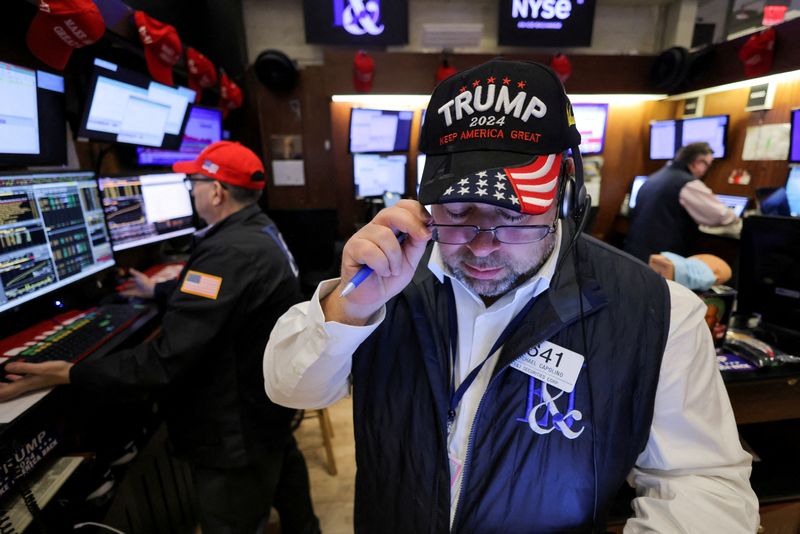
Analysts weigh in on Trump’s tariff threats
Investing.com — President-elect Donald Trump pledged on Monday to impose significant tariffs on the United States’ top three trading partners—Canada, Mexico, and China—outlining measures that could escalate into trade disputes. The proposed tariffs are part of Trump’s broader effort to fulfill his “America First” campaign promises.
The former US president, set to retake office on January 20, stated that imports from Canada and Mexico would face a 25% tariff until those countries take stronger measures to combat drug trafficking, particularly fentanyl, and migration across the US border. This approach could potentially violate existing free trade agreements.
On China, Trump pledged “an additional 10% tariff, above any additional tariffs” on imports, though the exact implications remain unclear. In the past, he has suggested revoking China’s most-favored-nation status and imposing tariffs exceeding 60% on Chinese goods—significantly higher than those enacted during his first term.
The announcements, made through two posts on Truth Social, offered some of Trump’s most detailed plans for implementing his economic platform since his election victory on November 5.
“On January 20th, as one of my many first Executive Orders, I will sign all necessary documents to charge Mexico and Canada a 25% Tariff on ALL products coming into the United States, and its ridiculous Open Borders,” Trump wrote.
The US market is key for its trading partners, accounting for over 83% of Mexican exports and 75% of Canadian exports in 2023. The proposed tariffs could also disrupt supply chains for foreign companies, particularly Asian manufacturers of automobiles and electronics, which rely on Mexico as a cost-effective production hub for the US.
Regarding China, Trump accused Beijing of failing to take adequate steps to stem the flow of illicit drugs into the US from Mexico.
“Until such time as they stop, we will be charging China an additional 10% Tariff, above any additional Tariffs, on all of their many products coming into the United States of America,” Trump said.
Responding to the announcement, Liu Pengyu, a spokesperson for the Chinese embassy in Washington, reiterated China’s position that trade between the two countries is mutually beneficial, warning that “no one will win a trade war or a tariff war.”
What analysts say
Vital Knowledge: “With the favorable Gaetz and Bessent news, investors were hoping the “Trump Tade” would get back on track at least until the end of the year, but the Monday night tariff announcement could have the same effect as the four controversial cabinet picks during the week of 11/11, with the SPX stalling until investors get a firmer read on Trump 2.0 policies.”
“We wouldn’t be surprised if the Mon night tariff threat is never implemented, but there are still some huge contradictions at the heart of the present Trump narrative.”
ING: “Whilst most in the market assume that Trump will be using tariffs as a large bargaining stick – in this case to tighten US border controls – we would be careful of dismissing their market impact as some grandstanding. If 25% tariffs came close to seeing the light of day in Mexico, USD/MXN would be a 24/25 story, not just 21. We already think the currencies of Mexico and Canada will have a tougher Trump 2.0 than they did during his first term.”
“Although the final outcome of the tariff threat may be less severe once negotiations are concluded, we recommend adopting a defensive stance in FX markets for the time being.”
Danske Bank (CSE:DANSKE): “Despite his messages on Truth Social suggesting significant tariffs, the resilience of Asian markets this morning is notable. This could be attributed to Trump’s focus on the 10% rather than the 60% tariffs. Yesterday, Canada and Mexico were the first targets, with Trump proposing 25% tariffs referencing drugs and immigration issues. It is important to remember that the largest import from Canada to the US is energy, and it is difficult to envision the US imposing a 25% tariff on energy.”
Bank of America: “Our view is that the threat of tariffs is the instrument Trump would use to extract from other countries the economic and political outcomes that he considers best for America. We expect Canada and Mexico to show willingness to negotiate on the above issues to avoid tariffs.”
Barclays (LON:BARC): “We view announcement as largely negotiation tactics (as seen in 2016), and see such magnitude of tariffs unlikely.”

